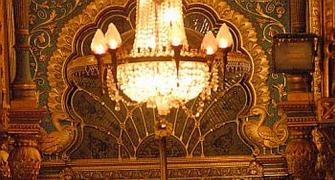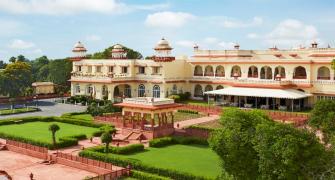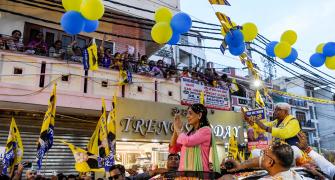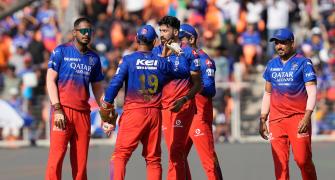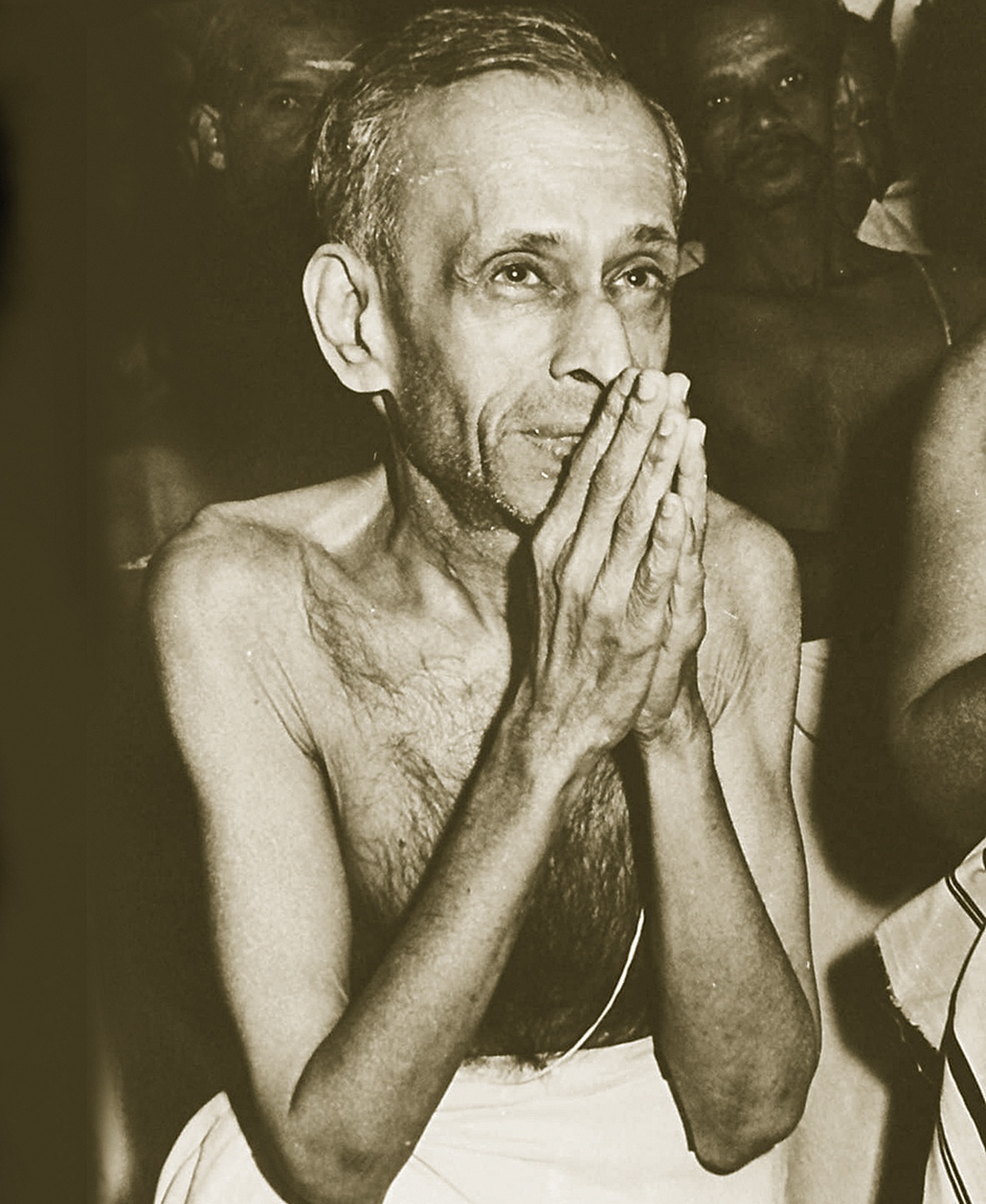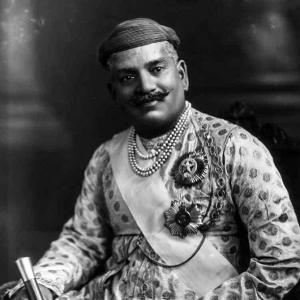When Jaipur's Maharaja Madho Singh was invited to attend King Edward VII's coronation in 1902, he chartered a ship for Rs 15 lakh for the journey.
He also carried 27,000 litres of Ganga jal on board.
Prakash Bhandari recalls the maharaja's voyage to attend a British monarch's coronation on a day when Charles III will be crowned king at Westminster Abbey.
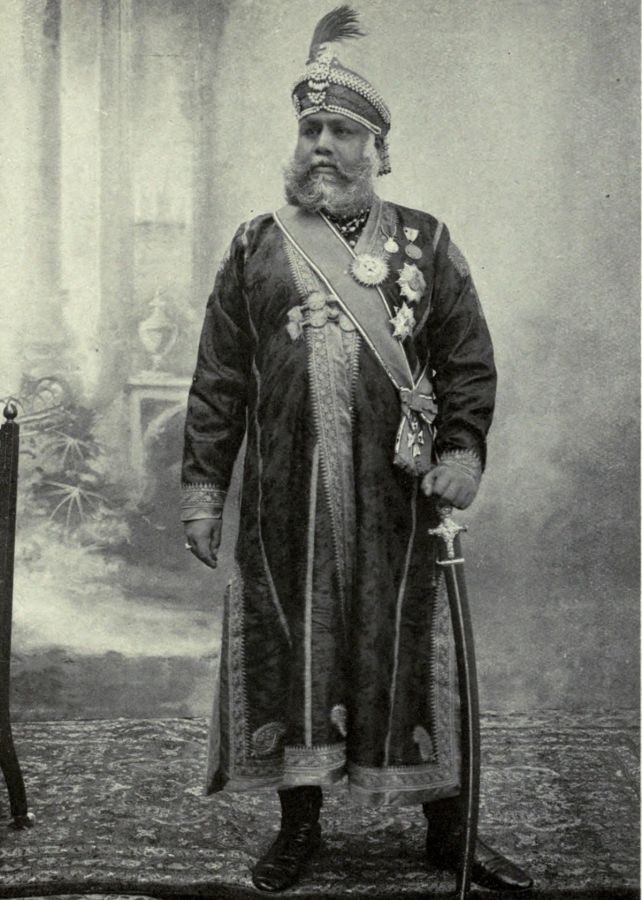
By the time Queen Victoria became empress of India, most of the Indian rulers had bowed to Great Britain, accepting it as a paramount power.
The 500 plus Indian principalities accepted the British monarch's sovereignty unconditionally.
So did Sawai Madho Singh of Jaipur.
A distant relative of his predecessor Maharaja Ram Singh II, who adopted him, he came to the throne on Ram Singh's death. Born Kaim Singh, he had worked as a cavalry rider in the army of the nawab of Tonk after his exile from the small state of Isarda, where his father had been the thakur. But he was fated to be king and, as luck would have it, inherited Jaipur state instead.
Madho Singh stood a little over six feet. He liked the good life and married five times. His numerous mistresses lived too under his roof in the palace. But Madho Singh could not produce a son from his official maharanis and was forced to adopt a son from within his family.
The maharaja acknowledged the paramountcy of the British and always strived to keep the viceroy in good humour. He sent his troops and horses to assist the British in the fighting in Chitral (current day Pakistan) in 1894-1895, the Tirah Campaign (now in Pakistan's Khyber Pakhtunkhwa province) in 1897-1898, and in the South African War.
In the First World War, he again sent his men and guns to assist in the campaign in Mesopotamia at his own expense.
Madho Singh was appointed an honorary major general, was made Knight Grand Commander of the Order of the Star of India, received the Order of the Indian Empire and was made a Knight of the Grand Cross.

IMAGE: Maharaja Sawai Madho Singh.
Photograph: Kind courtesy Wikimedia Commons
After Queen Victoria died in 1901, the coronation of her eldest son Edward VII was scheduled for 1902 and representatives of Britain's vast empire were expected to be present in London on the grand day.
A reluctant Madho Singh wanted to avoid going to England. He was a devout bhakta of Govind Deoji, whom he worshipped every day. Though he was loyal to the British crown, he called the British mleccha or barbarians.
The priests of Jaipur state were against their maharaja's vilayat visit. They said the voyage would lead to the ruler losing his varna (caste).
The maharaja was afraid to defy the priests, but the British officers he liaised with told him that if he failed to attend the coronation, it would be treated as a violation of protocol. The maharajas of the other states in Rajputana and elsewhere were all going for the coronation.
Madho Singh was not literate -- he could barely sign his name in Hindi -- but was gifted with worldly knowledge. He sent his trusted officials to instruct the priests to find a solution.
The priests decided that the maharaja could travel by ship to Britain provided he cooked his own food, untouched by meat and beef. He was also asked to take along idols of the family deity on board the ship, but a special cabin, with Jaipur soil in it, should be created for the deity.
His meals would have to be offered to the gods before he could partake of them.
He was asked to take Ganga jal with him for the trip; he could only eat meals cooked with Ganga jal and drink only Ganga jal.
To have enough holy water to last the sea journey and for his two month-long stay in London required packing gallons and gallons and gallons of Ganga jal.
A team of silversmiths, headed by Govind Narain and his deputy Mahadev, worked for months to prepare a huge jar that could hold 9,000 litres of water. Three such jars made of pure silver were made.
These silver jars -- each weighing 375 kilos and 1.6 metres high with a circumference of 4.5 metres -- were first tested to ensure that they were leakproof and then sent to Haridwar to fill with Ganga jal.
Today, you can see these silver urns at Jaipur's City Palace. Today, the silver alone for a similar urn would cost Rs 12 million.
Some 27,000 litres of water were estimated to be sufficient for the maharaja's use for two months in England.
The SS Olympia was booked for the then whopping fee of Rs 15 lakh for the trip from Bombay to London. The cost, at today's prices, would be 450 million.
The ship which was made in France and was fitted with six special suites.

The first and most important suite on board the SS Olympia was reserved for the family deity Lord Gopalji, whose idols were to accompany the maharaja.
The second suite was occupied by Maharaja Madho Singh.
The third was sanctioned for the royal priests.
The fourth was meant for the prime minister of Jaipur state, Sansar Chandra Sen.
During the voyage, Sansar Sen's son Abinash Chandra Sen worked as the private secretary to the maharaja; his uncle Dr Hem Chandra Sen traveled as the personal physician.
Two other suites were reserved for senior members of the maharaja's entourage.
125 nobles, ministers, cooks, personal attendants and two doctors accompanied the maharaja.
The ship was washed with Ganga jal that was brought by a special train from Haridwar to Bombay port. The purification of the ship was conducted under the supervision of Raj Acharya Laxmi Narayan Bhatt, the maharaja's chief priest. Twenty-five priests traveled from Jaipur to perform the ship's puja.
"My grandfather Raj Acharyaji performed the Sagar Puja (worshipping the sea) which the Kachhawa rulers claimed was similar to the rituals performed by Lord Ram before conquering Ravan's Lanka," says Kailash Bhat, a senior advocate and Raj Acharya Bhatt's grandson.
"As the ship started leaving the dock, the priests chanted mantras for the maharaja's safe journey. The maharaja stood on the deck to bid farewell. The ship would chug at a speed of 20 knots covering a distance of 2,000 metres in an hour," adds Bhatt.
Two days before the departure, 25 priests from Jaipur performed another puja to propitiate Varuna, the presiding deity of the ocean. Symbolic gifts of gold, silver, pearls, diamonds and gold coins were dropped in the sea as part of the religious ceremonies.
"The offerings dropped in the sea in Bombay were worth several lakhs," says Bhatt.
Hundreds of fishermen thronged the waters around the ship in Bombay and dove into the sea to fish out these precious offerings of gold, silver, pearls and diamonds.
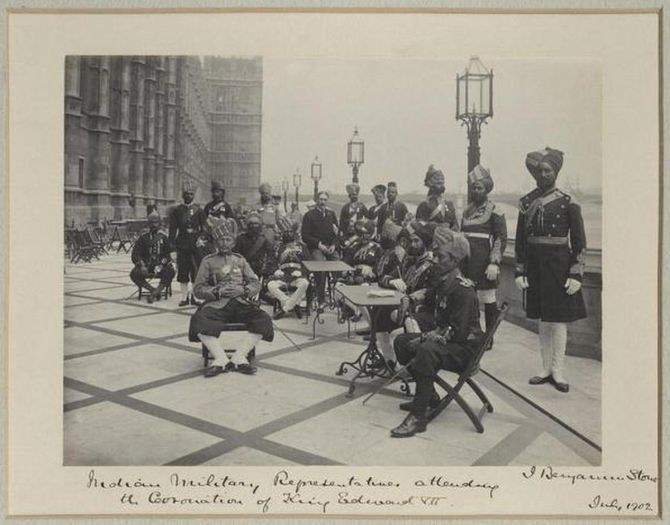
The maharaja had not seen the ocean before and the journey was quite an experience for him and his traveling party. He was a tad nervous for the first two days, but the ship's captain calmed him and took him up onto the deck to show him the splendour of the sea.
When the ship ran into a mild storm which terrified the maharaja, the captain convinced him that such storms are common during a sea journey. Madho Singh instead rushed to the deities' suite to offer prayers.
"We heard stories that as the ship was passing through the Red Sea, a huge storm rocked it mercilessly," Dr Gautam Sen, an eminent cardiac surgeon in Jaipur and Sansar Chand Sen's great-grandson, recalls.
"The crew and passengers feared the ship would sink. It was proposed that one of the silver urns be thrown overboard to appease the Red Sea. As soon as it was done, the sea quietened, and the journey progressed without any further hindrance," Dr Sen adds.
When the ship reached Aden, the first stopover, the maharaja learned that a German ship had been caught in a storm and only 11 out of the 43 crew members survived. This news worried Madho Singh ever more. The captain told him not to worry and convinced him that he would reach England safely.
When the ship reached Southampton, the maharaja was received by British officials. Accommodation for Madho Singh had been secured in advance at a huge, comfortable, lodge; members of his entourage were lodged nearby.
The maharaja took up residence, along with the deities, in the lodge.
It was summer in England and Madho Singh spent his time in the run-up to the coronation on August 9, 1902, visiting different parts of London.
On June 3, 1902, the maharaja, accompanied by a procession of Indian gods, were spied on the streets of London. The priests carried the idols on their heads while the maharaja walked barefoot through the city.
Madho Singh's sightseeing procession with his deities was the first of its kind in London and much talked about. Londoners were amazed to see the priests chanting mantras as the maharaja of Jaipur, clad in a specially stitched long silky robe, bedecked in the choicest jewellery of his kingdom, walked through the city streets.
While in England, Madho Singh took to scrupulously cleaning his hands with soil carried from India and then washing them with Ganga jal each time he shook hands with Englishmen.
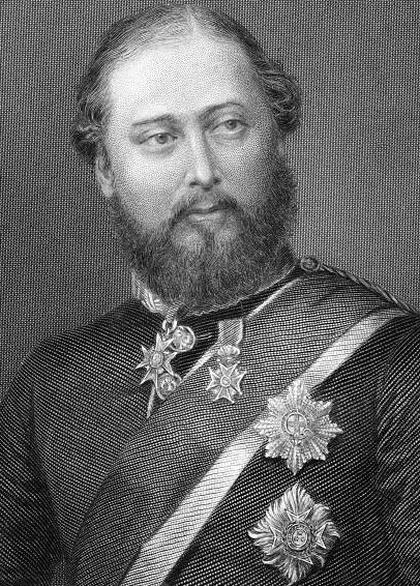
IMAGE: King Edward VII.
Madho Singh presented King Edward VII with a 2,000-carat diamond-encrusted sword made by a famous jeweller of Jaipur, Seth Banji Tholia. This sword was made of steel and gold, enamelled in blue, green and red. The diamonds were set in a lotus shape with green leaves made of emerald.
It's said Madho Singh did not attend the coronation dinner as he would not eat the food served there and returned to his lodge to have a quiet dinner amongst his own.
After a long and interesting visit to Britain, Madho Singh began his journey home. On the voyage, the SS Olympia sustained damage because of the choppy seas and had to be repaired in Aden before they resumed their journey to Bombay.
The maharaja celebrated his birthday on board and presented his family deity with 41 gold coins.
On his arrival in Bombay on September 12, 1902, Madho Singh rewarded the crew to thank them for the safe journey. On his return to Jaipur by train, the maharaja was given a big reception by his subjects.
His coronation adventures ended up being one of the high point of his royal life.

Feature Presentation: Rajesh Alva/Rediff.com

